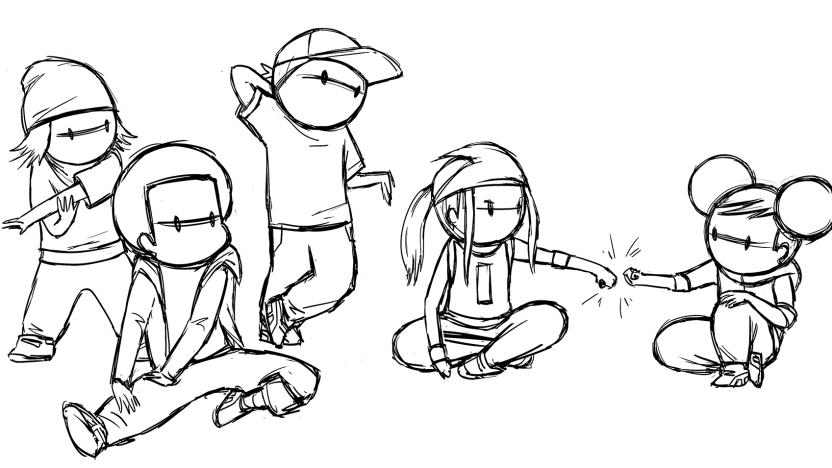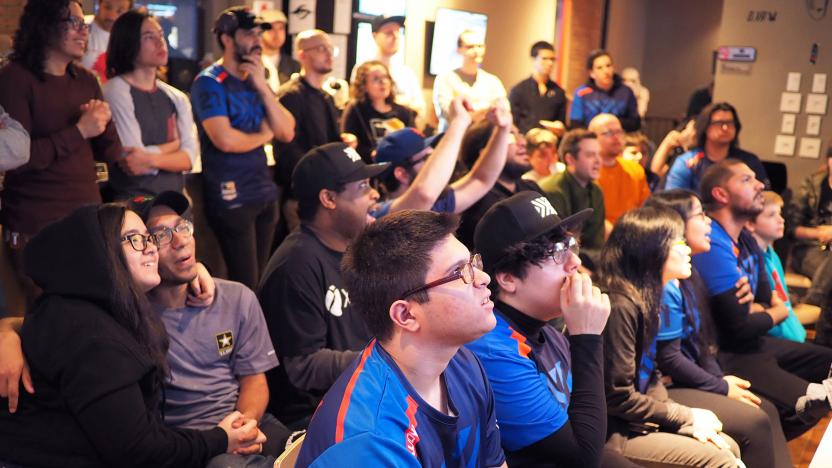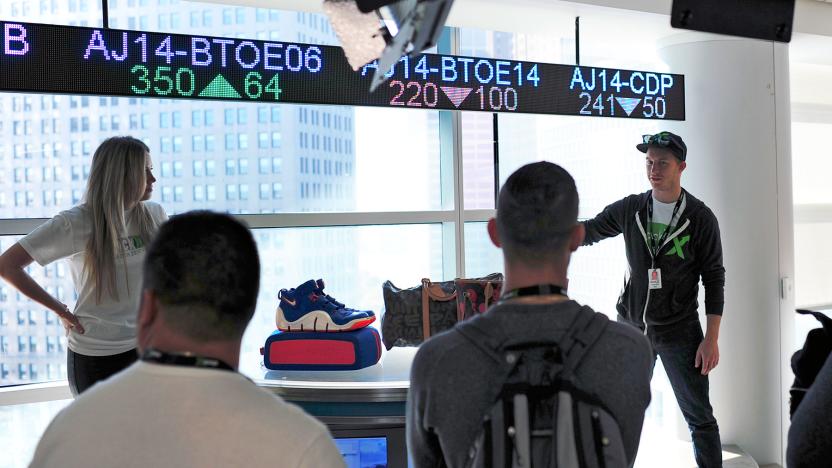longread
Latest

How child-security apps lengthen the reach of parents
My son recently turned 3 years old. Now that he's a "big boy," he wants to explore and run ahead of me, even though he lacks the wherewithal and caution to do so. My instincts, as a first-time father, are to hold onto him for dear life. I can't hold onto my son forever. But there are steps I can take to lengthen my reach before I let go entirely. Via GPS and beacon technology, developers are creating child trackers -- security apps and hardware to address the modern parent's primary preoccupying concern: "Where is my child right now?"

Designing a spaceship for the Guardians of the Galaxy
Avengers: Infinity War is a jam-packed movie set on multiple planets and spaceships. It moves at a rollicking pace too, flipping between superheroes young and old as they try to counter Thanos and the power of the mysterious Infinity Stones. Almost every scene required a tremendous amount of computer-generated visual effects. Marvel used a small army of external partners to complete the project, including a company based in London and San Francisco called Territory Studio. The independent team worked on 130 animated "screens" -- beautiful but entirely make-believe software -- for five different sets, including a new spaceship for the Guardians of the Galaxy.

'Eve Online' turns 15 today, and its history is epic
Today is the 15th anniversary of the legendarily fascinating virtual world EVE Online, a massively multiplayer spaceship game that has become famous for the incredible stories that sometimes emerge from the community about heists and wars between thousands of players. EVE is so interesting that it even has its own historian, Andrew Groen, a video game writer formerly of Wired who studies the politics and sociology at work in EVE's virtual community over its 15-year history. Groen raised $95,729 from a Kickstarter campaign to independently publish his first book, Empires of EVE: A History of the Great Wars of EVE Online, which has now sold 17,000 copies worldwide and is in its third printing. He's currently Kickstarting a sequel which has already brought in more than $115,000 in support and concludes this week. Empires of EVE is half Star Wars, half Decline and Fall of the Roman Empire. It is a true and fact-checked account of what happened inside EVE Online from the years 2003-2009 as player factions began to accumulate power and eventually wage a years-long war between more than 50,000 real players. It's a space opera that takes place on our own internet, and all the characters are 2003 internet users attempting to build their own digital fiefdom. The excerpt that follows is chapter four of Empires of EVE, and takes place near the beginning of the story.

To find a job, play these games
I am trying to fill animated balloons with water without them bursting. I watch my laptop screen with laser focus, rapping the space bar as soon as a green dot appears. I weigh how much money to trade with an imaginary partner in a scenario akin to the prisoner's dilemma. This is all in service of finding me a job. It hasn't just been me. This is the exact process that about a million applicants have followed to apply for positions at companies like Tesla, LinkedIn and Accenture. The platform that runs these games is Pymetrics, which somewhat whimsically dubs itself as a Hogwarts "sorting hat" for careers. The idea is that its games -- measuring 90 "cognitive, social and personality traits" -- provide more-objective markers of job compatibility than the traditional CV, cover letter and interview. If you're rejected from the position you wanted, the system can pair you off with what it deems a better match.

'Super Mario 64: Ocarina of Time’ is the perfect Nintendo mashup
Super Mario 64 is considered to be one of the greatest video games of all time. Its large, imaginative levels and increasingly difficult challenges have defined the 3D platformer genre since its release on the Nintendo 64. Similarly, The Legend of Zelda: Ocarina of Time — the first in the franchise with 3D graphics — is considered a classic with a record 99 rating on Metacritic. Both have been celebrated with portable re-releases and a deluge of fan movies, artwork and soundtrack remixes. But never have the two games been combined in a fan-made ROM hack like Super Mario 64: Ocarina of Time.

Our democracy is broken. Why can't technology fix it?
Something is rotten in the state of America. For a nation that has for so long promoted itself as a global champion of democratic ideals, we have a rather difficult time practicing what we preach. Outdated election mechanisms like the Electoral College and potential interference from hostile foreign powers aside, Americans have historically proven themselves reticent to participate in choosing their leaders. Turnout for presidential elections hasn't topped 65 percent of the eligible population in the past 100 years nor has it even come close to cracking 50 percent for midterms over the same period. During the 2016 election, just 63 percent of the U.S. civilian voting-age population showed up at the polls, according to the US Election Assistance Commission, with just five states -- Colorado, Maine, Minnesota, New Hampshire and Oregon -- managing to break 70 percent participation. Only 42 percent of Hawaiians bothered to vote.

‘Floor Kids’ is Kid Koala’s video game tribute to breakdancing
Kid Koala is not a game developer. Born Eric San, the Canadian DJ and turntablist has been spinning records and making beats since he was 12. Over the past three decades, he's DJ'd breakdancing battles and worked with legends of the electronic music scene like Amon Tobin. He's also scored films, written graphic novels and even collaborated with Mike Patton of Faith No More and Dan the Automator on an album of "love" songs. But he is not a game developer. Like many, he grew up playing Super Mario Bros., and back then if you'd told him one day he'd work with Nintendo, he'd never have believed you. His latest project is Floor Kids, a rhythm game that's a celebration of breakdancing culture. It's something he worked on, one way or another, for over ten years. The game was released last December for Nintendo Switch as part of the company's "Nindies" program. When San and creative partner Jonathan "JonJon" Ng were first approached by Nintendo, neither had any idea what a Switch was, but agreed anyway. "Nintendo was like some company from outer space that created this awesome game," he said. "It was a no-brainer for me." Now, the game is coming to PC, PlayStation 4 and Xbox One very soon.

In pursuit of the perfect AI voice
The virtual personal assistant is romanticized in utopian portrayals of the future from The Jetsons to Star Trek. It's the cultured, disembodied voice at humanity's beck and call, eager and willing to do any number of menial tasks. In its early real-world implementations, a virtual receptionist directed customers ('To hear more menu options, press 9'). Voice-typing software transcribed audio recordings. It wasn't until 2011 that Apple released Siri and the public had its first interactions with a commercially viable, dynamic personal assistant. Since Siri's debut with the release of the iPhone 4S, Apple's massive customer base has only gotten larger; the company estimates that more than 700 million iPhones are currently in use worldwide.

Ascape Audio and the economics of making headphones in America
Ascape Audio's home page proudly proclaims "Designed in Detroit," but at this point it's not helping business. "It hasn't made any goddamn impact," marketing director Dean Clancy said. "I want to put that in as many places as possible, because regardless of how it impacts our sales, I just want people to know we're doing it here," he said. "Designed in Detroit" they may be, but economics makes manufacturing Ascape's earbuds in the Motor City impossible. President Paul Schrems estimated it'd take at least $5 million to build a factory and staff it, so the company has offshore-manufacturing contracts for the wireless earbuds it designs in the D. "These things I wanna make are not made here," Schrems told me recently.

'Away' is a full-length CG movie made by one person
A boy dangling from a tree in a barren desert. A forest filled with standing stones that have circular holes punched through them. Turtle-riding cats. Spooky caves. Curious elephants. These are just a few of the shots in the first trailer for Away. The 3D animation is far from perfect, but there's a clear, distinctive style throughout. The most impressive part, though, is revealed in the video's description: "Animated feature film by Gints Zilbalodis." Unlike the latest Pixar movies, Away is being made by just one person. It's a colossal challenge, but one that the 23-year-old animator has been building toward for eight years.

Cheers, chants, and 'Overwatch' at NYC’s first eSports supporters club
Richard Ng didn't plan it this way, but he might just be standing at the forefront of an eSports revolution. The 38-year-old brand strategist finds himself moonlighting as the founder of the Five Deadly Venoms Crew, a supporters club for Overwatch League's New York Excelsior team. What started as a simple Discord request to meet up with nearby eSports fans has quickly grown into a local phenomenon, hosting weekly, standing-room-only viewing parties at Waypoint, a cozy LAN café on the Lower East Side. This past weekend's event had more than 70 attendees -- a lively, exuberant crowd that found plenty of reason to cheer as NYC routed the Los Angeles Valiant 4-0. "There were no lofty aspirations at first," said Ng, as he recalled the group's humble beginnings. "We had 15 people come out for the first one, and it just snowballed from there."

The story of the Duke, the Xbox pad that existed because it had to
Denise Chaudhari had never touched a gamepad before stepping onto Microsoft's campus as a contractor. The first woman to join the Xbox team, Chaudhari had studied ergonomics and industrial design at the prestigious Rhode Island School of Design but didn't have any experience with joysticks. That's part of why Xbox's Jim Stewart was so excited to bring her on board: Her ideas wouldn't be based on preconceived notions of what a gamepad had to be. It was early 2000, and the company was preparing to enter the gaming world with the Xbox. In Nov. 2001, the console was released in North America alongside the Duke, a controller that seemed comically large compared to its contemporaries. Within a year, the oversize gamepad was abandoned by Microsoft and replaced with a smaller model, but the Duke has had an impact on every controller since.

Lab-grown meat is inevitable. Will we eat it?
In 2013, two people tasted a burger made from cultured meat live on the air, and for many, it was their first introduction to lab-grown meat and the researchers creating it. The two were tasked with trying this first cultured burger and giving their honest thoughts on how it tasted, how it felt and how it compared to a typical burger. One noted "some intense taste" while the second said, "The texture, the mouthfeel has a feel like meat." Both pointed out that the lack of fat in the burger made it a little dry, but overall the consensus was that it was very close to traditional meat. Now, less than five years later, no fewer than seven companies are developing cultured meat to bring it to the market, some aiming to sell products as early as this year. For some, cultured meat is a tech triumph, for others it's a cool new food and for many, it offers a way to help address some pretty major food and environmental challenges or maybe even save the world. But it's also a fundamental break from how we've always interacted with meat. Eating meat has always meant the death of an animal in some way or another, but with cultured meat, that's no longer the case. And while that's pretty awe-inspiring, it's also, let's face it, really weird. Whether cultured meat becomes a commercial reality this year or a decade down the road, it's likely on its way, so it seems wise to figure out what people think of it, how to get people to trust it and ultimately, how to sell it.

Inside Google’s plan to build a smart neighborhood in Toronto
On the Sidewalk Labs website is a 200-page document explaining its vision for a smart neighborhood in Toronto. It's packed with illustrations that show a warm, idyllic community full of grassy parks, modular buildings and underground tunnels with delivery robots and internet cabling inside. The text describes "a truly complete community" that's free of cars and committed to reducing its carbon footprint. Underpinning everything is a network of sensors that can monitor noise, traffic and pollution, collecting the troves of data required to understand and improve the city's design. Flipping through the pages, it's easy to see how the company -- an offshoot of Google parent Alphabet -- was chosen to revitalize the Lake Ontario waterfront. The lengthy pitch document, however, is just a taste of what the area might become. It's a dreamy but meticulously thought-out mood board summarizing what Sidewalk Labs has been pondering for the past two years. Reading it cover to cover, you can get lost in the scale and ambition of such a project. Most companies would struggle to execute just one aspect of the plan: autonomous transit, for instance, or buildings that can be quickly and cheaply repurposed depending on the time of day or needs of the city. Sidewalk Labs, however, wants to do it all.

What’s so funny about technology?
Moments after he stepped onstage, Joe Leonardo sensed the crowd would be difficult to win over. It was a recent Tuesday evening at the Peoples Improv Theater, a New York comedy venue with photos of Stephen Colbert, Will Ferrell and Tracy Morgan on the walls and mantras -- "Follow the fear" -- next to the stage entrance.

China's Xinjiang surveillance is the dystopian future nobody wants
In July 2009, deadly riots broke out in Urumqi, the capital of Xinjiang, China. Nearly 200 people died, the majority ethnic Han Chinese, and thousands of Chinese troops were brought in to quell the riots. An information battle soon followed, as mobile phone and internet service was cut off in the entire province. For the next 10 months, web access would be almost nonexistent in Xinjiang, a vast region larger than Texas with a population of more than 20 million. It was one of the most widespread, longest internet shutdowns ever. That event, which followed similar unrest in neighboring Chinese-ruled Tibet in 2008, was the sign of a new phase in the Chinese state's quest to control its restive outer regions. The 2009 shutdown was the first large-scale sign of a shift in tactics: the use of technology to control information. "Xinjiang has gotten little attention, but this is where we're really seeing the coming together of multiple streams of technology [for surveillance] that just hasn't happened in other contexts before," said Steven Feldstein, fellow in the Democracy and Rule of Law Program at the Carnegie Endowment for International Peace. Nine years later, Xinjiang has seen the widespread implementation of sophisticated high-tech surveillance and monitoring technology, what BuzzFeed called "a 21st century police state." But what happens in Xinjiang does not stay in Xinjiang. The technologies piloted there are already spreading across all of China, and there are even early signs that Chinese companies are beginning to sell some of this technology to other authoritarian-minded countries. If this trend continues, the future of technology, particularly for those in the Global South, could more resemble what's happening in Xinjiang than developments in Silicon Valley.

Why sneakerheads are leaving eBay for Detroit startup StockX
Buying a pair of new rare sneakers is harder than reselling them on StockX. To buy new, the Yeezy or Jordan gods have to smile upon you, giving you that winning raffle ticket at a local store or letting you beat the bots online. To resell, all you have to do is go to the StockX website and set a price. You don't take photos or haggle with potential buyers. Instead, you look at what price the shoes are selling for and list your pair at whatever amount you think someone will pay for them. Like a stock exchange, buyer and seller identities are kept from one another. StockX acts as a middleman, only releasing payment once it verifies that goods are authentic. It's this simplicity that has helped the company earn so many loyal users. StockX was founded in 2015 after Quicken Loans founder and CEO Dan Gilbert bought Campless -- an online repository for sneaker sales data -- from Josh Luber. As part of the purchase, Luber moved from his native Philadelphia to the Detroit metro area, taking up the mantle of StockX CEO and working from Gilbert's One Campus Martius building downtown. In a little under three years, the company has become the go-to source for buying rare high-end shoes and streetwear.

How Elon Musk plays on our science fiction dreams
Elon Musk has said that he wants to die on Mars -- after it's been colonized by his company SpaceX. He may not have the precise details yet, but Musk will figure out the mission in style: The SpaceX space suits are sleek and form-fitting, while his cherry red Tesla sports car will be aboard the maiden flight of the interplanetary Falcon Heavy rocket. Meanwhile, on Earth, he'll work on connecting our brains to computers through tiny electrodes, building underground networks of car sleds that function like a personal subway system, firing passenger trains through a vacuum tube at the speed of sound and replacing air travel with his Big Fucking Rocket (BFR) spaceship that gets passengers anywhere on the planet in under an hour. That's without mentioning his efforts to advance electric cars and solar energy. Or the fact that this week, he made $10 million in four days by selling promotional flamethrowers.

Technology can’t save football players' brains
Tregg Duerson was 25 years old when his father committed suicide in 2011. A former defensive back for the Chicago Bears, New York Giants and Phoenix Cardinals, David "Dave" Duerson made a career out of being one of the most feared tacklers during his 11-year stint in the National Football League. His skill set helped him win two Super Bowl championship rings, one with the Bears in 1985 and another with the Giants in 1990, cementing his legacy as one of the NFL's all-time greats. Along the way, he was also selected to the Pro Bowl, a postseason game that rewards the league's best players, four consecutive times from 1985 to 1988. Duerson had the NFL career most players can only dream of, but it ultimately cost him his life.

The state of solar installers after Trump’s tariff
Two days after President Donald Trump signed hefty tariffs on imported solar panels, a five-man team was hauling slabs of them up the outside of a brownstone in Brooklyn's Sunset Park. In below-freezing January winds, they set up steel tilt racks on the roof to hold 16 panels and wired the system to a solar inverter, making the power usable in the house and able to feed back into the electrical grid. The team from Brooklyn SolarWorks, an installation company with 21 full-time employees, finished the job around sunset.








